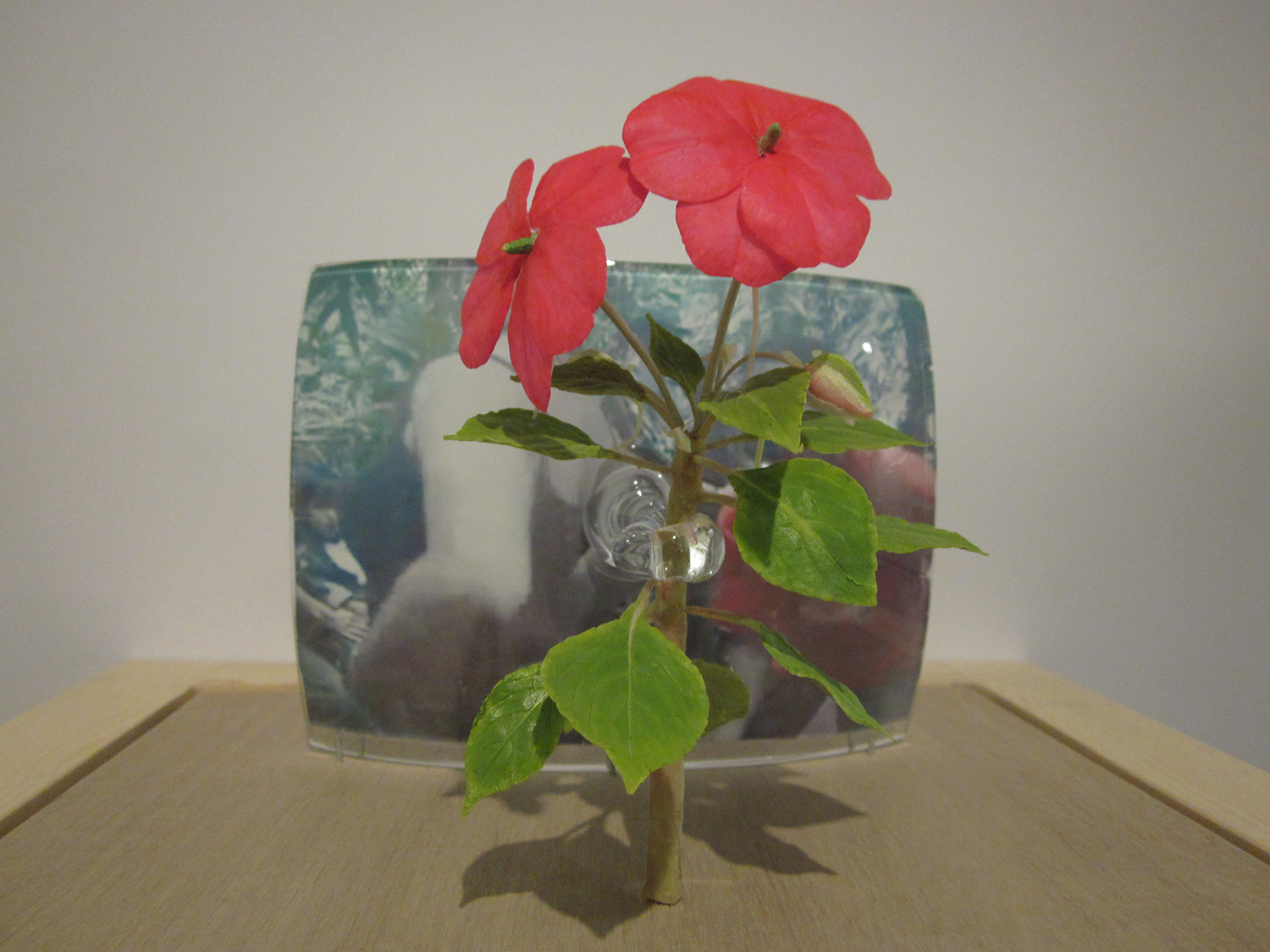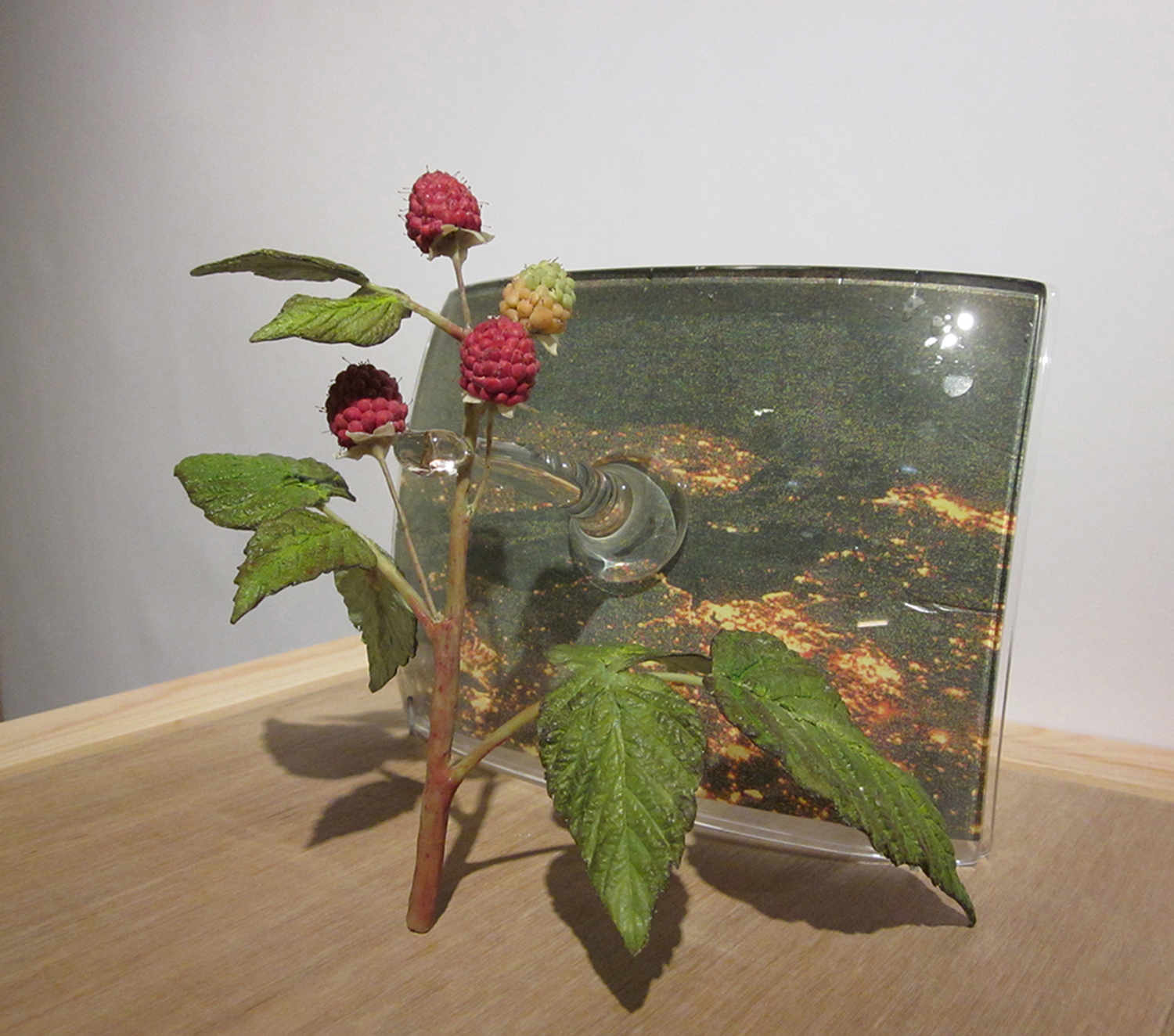4 seminal moments 4 small deaths, 2013
NOTES ON SLOW TIME, SEX AND DEATH
In 2013 I made a series of beeswax plant models with the training and assistance of National Museum of Wales botanical artists and conservators. Each model had to be made with the live plant available for the casting of its leaves and reproduction of its colour, form, patterning and (as one botanical artist put it) the ‘jizz’ of the plant: its essential and unique ‘aliveness’. Beginning with a large broccoli plant dug from my mother’s garden in January 2013, the making schedule was therefore dictated by the specific life or season of each plant. I had to complete each model before the plant faded or died in front of me.
To thread tiny polystyrene balls on to fine nylon fishing line before dipping each one into hot beeswax, coloured with pigment (and then burning the end of each protruding nylon line with a lighter to reproduce the tiny hair characteristic of a raspberry globule) before somehow managing to stick all these globules together with hot wax into the unique and distinctive shape of a raspberry, is to enter slow time. In the museum, plant models are now budget restricted rather than routinely made. In life, berry picking is a snatched activity with few people out on the hill when the whinberries are ripe (although I once met a fox coming up the mountain path to eat them - the path was littered with purple fox droppings - but no people).
Gathering plants and making wax plants feel like experiences of ‘limitlessness’: the state of the artist’s mind ‘making contact with matter’ as described by Robert Smithson.(1) As staff show me the museum’s collections of plants, animals, fossils, minerals and crystals and my mind encounters the vast geological ages of the museum’s specimens, it feels like another experience of ‘limitlessness’. On the other hand there is specificity. The museum staff show me how the specimens’ labels are often as revealing of historical colonisation, economic development, social connections and class as much as geographical, ecological or geological information. Equally my plants and their dioramic backdrops stage specific points of focus amidst what Manuel Castells has termed the ‘unidentified flows’ of globalisation.(2)
Until I pressed the wax- covered polystyrene balls together to make the raspberry and those round globules of wax turned into hexagons, I didn’t fully understand that the form of the raspberry is the way it has to be. In ecology, life finds the most economical use of space, and things find their balance (fruition or frustration) as they push up against each other. Reproduction is therefore a concentration of energy and order: the struggle to be fruitful, to fulfill one’s own fertility in one’s own ecological and cultural niche, against the odds or against the drift, against conflicting forces, time, death, entropy.
(1) Also described as ‘dedifferentiation’ in ‘A Sedimentation of the Mind: Earth Projects’, in Jack Flam, editor, Robert Smithson: The Collected Writings, University of California Press, Berkley and Los Angeles, 1996, pp. 100-4.
(2) Manuel Castells, The Information Age: Economy, Society and Culture, Vol. 2: The Power of Identity, 2nd edition, Blackwell, Oxford, 2004, pp. 8-9.
Supported by Arts Council of Wales and National Museum of Wales.
4 ennyd semenaidd 4 marwolaeth fach
NODIADAU AR AMSER ARAF, RHYW A MARWOLAETH
Yn 2013 lluniais gyfres o fodelau cŵyr gwennyn o blanhigion a hynny o dan hyfforddiant a chyda chymorth artistiaid botanegol a chadwraethwyr Amgueddfa Genedlaethol Cymru. Roedd rhaid gwneud pob model gyda phlanhigyn byw a oedd ar gael ar y pryd ar gyfer castio ei ddail ac atgynhyrchu ei liw, ffurf, patrymu ac (yng ngeiriau un artist botanegol) ‘jizz’ y planhigyn: y ‘bod yn fyw’ hanfodol ac unigryw. Gan ddechrau â brocoli mawr a balwyd o ardd fy mam yn Ionawr 2013, roedd amserlen y creu, felly, yn cael ei dra-arglwyddiaethu gan fywyd penodol pob model cyn bod y planhigyn yn gwywo neu’n marw o’m blaen.
Wrth edafu peli bychain bach polystyren ar linyn pysgota neilon main cyn dipio pob
un mewn cŵyr gwennyn poeth wedi ei liwio gan bigment (ac yna llosgi ymyl pob llinell neilon a ymwthiai allan â fflam i ddynwared nodweddion blewiach globwl mafon) cyn rhywsut lwyddo i ludo’r rhain i gyd at ei gilydd â chŵyr poeth i lunio siâp unigryw ac arbennig mafon, rydych yn camu i fyd amser araf. Caiff creu modelau planhigion ei gyfyngu gan gyllid bellach yn yr amgueddfa, yn hytrach na chael eu gwneud yn rheolaidd.
Mewn bywyd, mae hel aeron yn weithgaredd byrhoedlog â nifer fach o bobl allan ar y bryn pan fo’r llus yn aeddfed (er y gwnes i gwrdd â llwynog ryw dro yn dod i fyny’r mynydd i’w bwyta nhw – roedd y llwybr yn frith o faw llwynog – ond dim pobl).
Mae casglu planhigion a chreu planhigion cŵyr yn teimlo fel profiadau o ‘ddi- ben-draw-dod’: sef cyflwr meddwl yr artist sy’n ‘dod i gysylltiad â mater’ fel y’i disgrifiwyd gan Robert Smithson.(1) Wrth i’r staff ddangos i mi gasgliadau’r amgueddfa o blanhigion, anifeiliaid, ffosiliau, mineralau a chrisialau, ac wrth i’m meddwl ddodar draws oesoedd helaeth sbesimenau’r amgueddfa, y mae’n teimlo fel profiad arall o ‘ddi-ben-draw- dod’. Ar y llaw arall, ceir penodolrwydd. Mae staff yr amgueddfa’n dangos i mi sut y mae labeli’r sbesimenau’n aml yn datgelu’r un faint am wladychu hanesyddol, datblygiad economaidd, cysylltiadau cymdeithasol a dosbarth ag a wna gwybodaeth ddaearyddol, ecolegol neu ddaearegol. Yn yr un modd, mae fy mhlanhigion a’u cefndir dioramig yn llwyfannu pwyntiau penodol o ffocws ymhlith yr hyn y mae Manuel Castells yn ei fynegi fel ‘llif anhysbys’ globaleiddio.(2) Hyd nes i mi wasgu’r peli a orchuddiwyd â chŵyr at ei gilydd i wneud y fafonen ac i’r globylau crwn hynny o gŵyr droi’n hecsagonau, nid oeddwn wedi llwyr ddeall fod yn rhaid i ffurf y fafonen fod yr hyn ydyw. Mewn ecoleg, daw bywyd o hyd i’r defnydd mwyaf economaidd o wagle, a daw pethau o hyd i’w cydbwysedd (dwyn ffrwyth neu rwystredigaeth) wrth iddynt wthio yn erbyn ei gilydd. Y mae atgynhyrchu felly’n grynodiad o ynni a threfn: y frwydr i ddwyn ffrwyth, i gyflawni ei ffrwythlondeb ei hun yng nghynefin ecolegaidd a diwylliannol yr unigolyn, a hynny er gwaetha’r rhwystrau neu yn erbyn y lli, yn erbyn grymoedd sy’n gwrthdaro, amser, marwolaeth, entropi.
(1) Disgrifir hefyd fel ‘di-ddifferiad’ yn ‘A Sedimentation of the Mind: Earth Projects’, yn Jack Flam, golygydd, Robert Smithson: The Collected Writings, University of California Press, Berkley a Los Angeles, 1996, tt. 100-4.
(2) Manuel Castells, The Information Age: Economy, Society and Culture, Cyf. 2: The Power of Identity, 2il argraffiad, Blackwell, Rhydychen, 2004, tt. 8-9.
Cefnogwyd gan Gyngor Celfyddydau Cymru ac Amgueddfa Genedlaethol Cymru.

